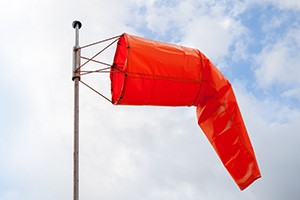What are Windsocks Used For? Eight Types of Worksites Where Windsocks are Necessary

Industries from manufacturing to transportation thrive on the newest, most advanced equipment, but many of the most crucial, reliable items at many worksites are the simplest. One of these is the windsock. You’ve probably seen these conical, tapered fabric tubes that, not surprisingly, resemble a giant sock.
Windsocks perform two functions: they indicate wind direction and intensity. They’re made of a brightly colored, high-visibility fabric that can be seen from a distance. Some have contrasting color stripes to help distinguish wind speeds, with each stripe representing an additional 3 knots (5.5 Km/h; 3.3. Mph).
Different industries use windsocks for many different purposes, from vehicle positioning to air hazard safety.
- Airports: Compared to the intricate monitoring equipment being used by pilots and control towers windsocks seem unnecessary, but they provide immediate visual confirmation for pilots of wind speed and direction while taking off and landing. The Federal Aviation Administration has specific requirements for windsock material, size, and ability to orient itself at particular wind speeds, and they’ll typically be lit internally or externally at night.
- Chemical plants: A windsock can save lives when a chemical leak occurs, allowing personnel to be moved to a safe distance away from the direction of the leak. Control of Major Accident Hazards (COMAH) regulations require windsocks at chemical plants.
- Construction sites: Wind can be hazardous for construction sites using heavy equipment. A windsock to monitor wind conditions is especially useful when working with top-heavy, tall equipment like cranes.
- Farms: Windsocks have many uses in agriculture, from monitoring severe weather to indicating wind conditions before spraying pesticides and herbicides. Understanding wind patterns can help farmers plan land use and seed more accurately.
- Landfills: Understanding a site’s wind patterns and topography, with the help of windsocks, guides landfill managers on how to store and block debris from blowing away. Landfills also may release gases which can pollute or cause health issues, and windsocks can help monitor this.
- Manufacturing facilities: Windsocks help monitor leakage of hazardous material used in production or storage systems, such as meat packing and cold storage facilities that use ammonia.
- Oilfields: Hydrogen sulfate is a dangerous, flammable gas that can occur in oil and gas formations, and windsocks help watch for potential drift. At higher concentrations, gases can very quickly overwhelm workers, causing “knockdown,” or sudden unconsciousness.
- Wastewater treatment plants: Hydrogen sulfate can also be generated by wastewater, along with other contaminants and dangerous microflora can be picked up by the wind in micro-droplets of water.
No matter how advanced environmental monitoring has become, windsocks are still necessary in multiple industries. For those working near airborne hazards, an immediate guide to wind conditions may be lifesaving. Understanding your environment is the first step to ensuring a safe working environment.


